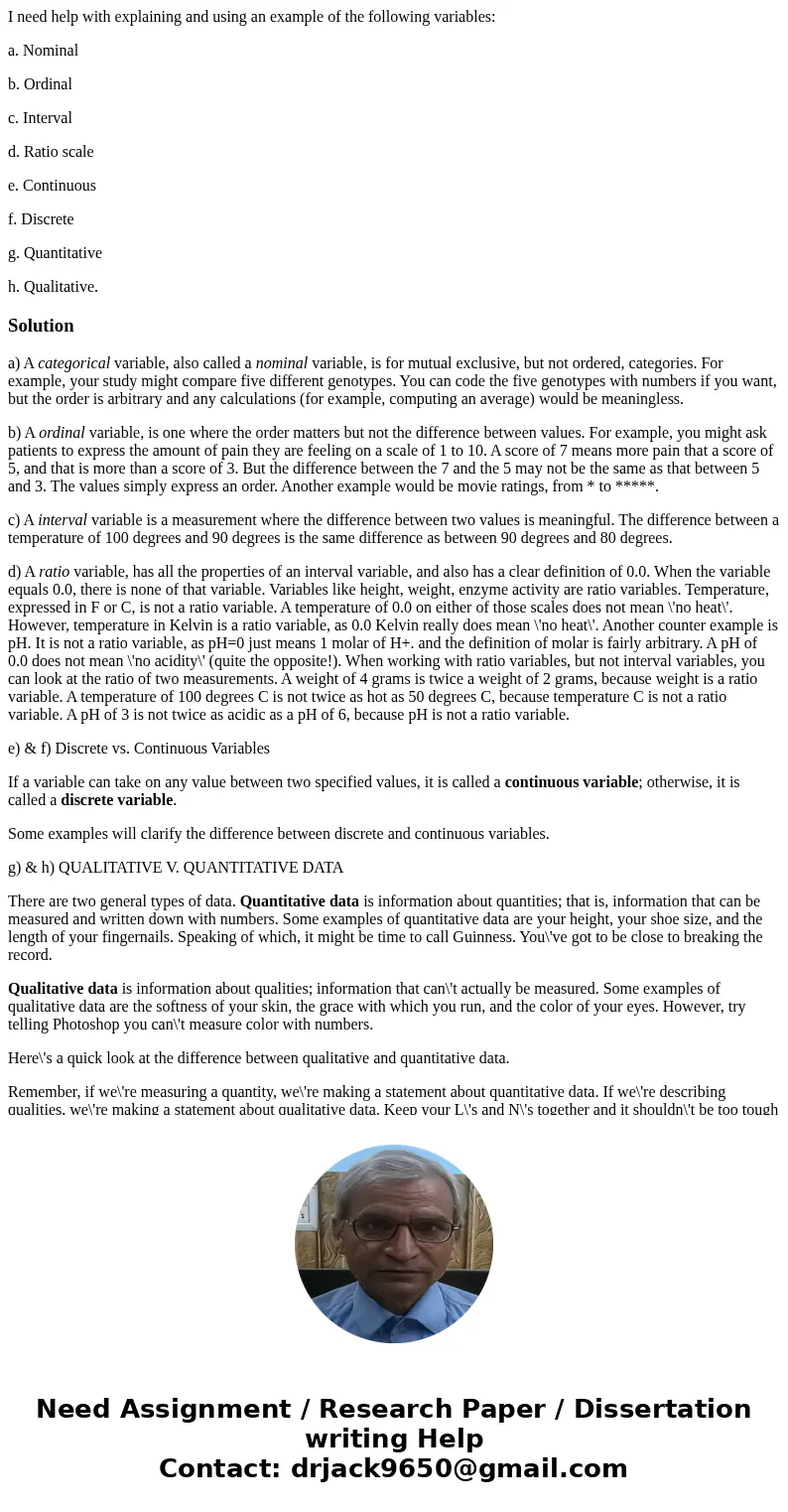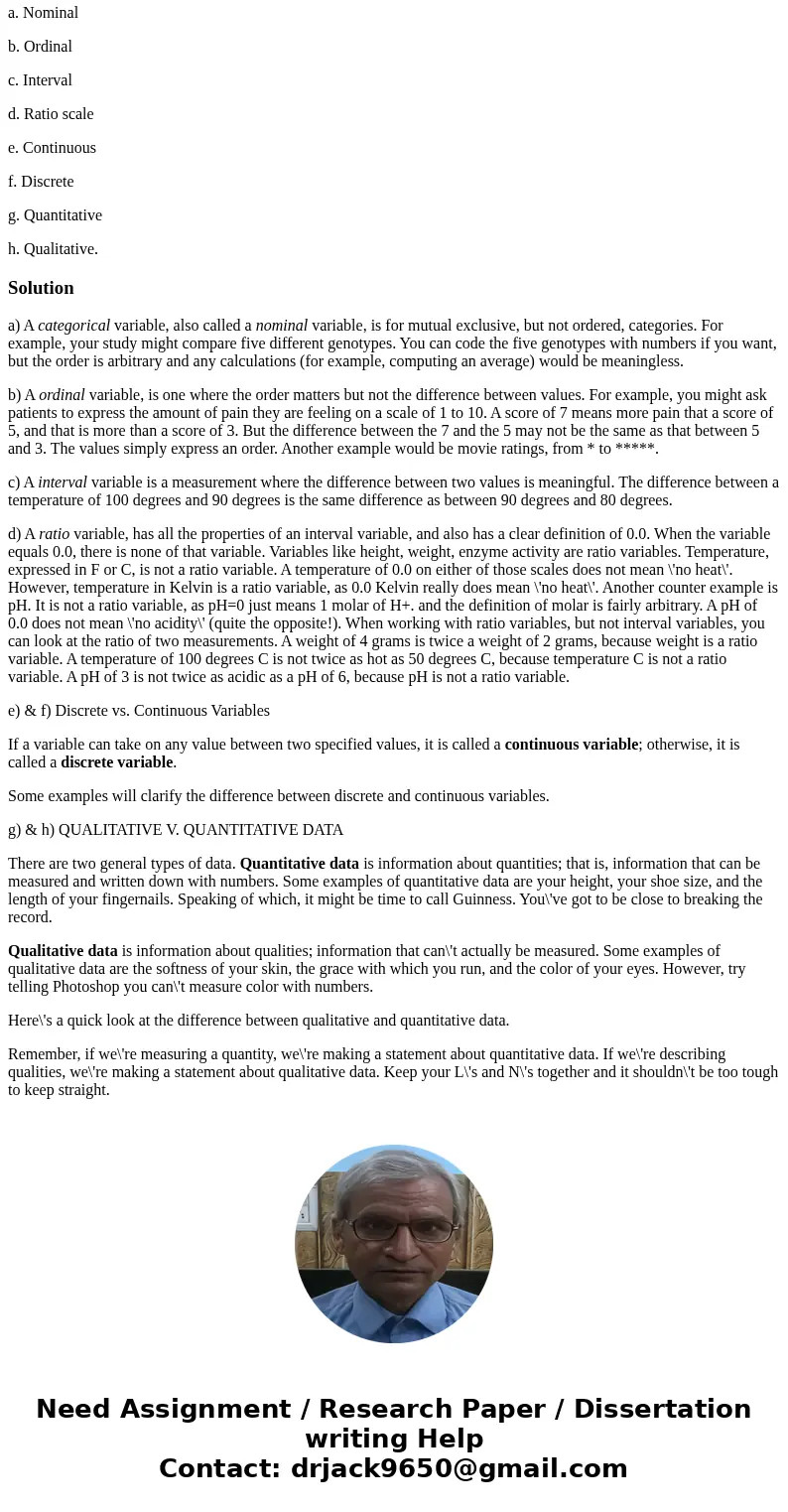I need help with explaining and using an example of the foll
I need help with explaining and using an example of the following variables:
a. Nominal
b. Ordinal
c. Interval
d. Ratio scale
e. Continuous
f. Discrete
g. Quantitative
h. Qualitative.
Solution
a) A categorical variable, also called a nominal variable, is for mutual exclusive, but not ordered, categories. For example, your study might compare five different genotypes. You can code the five genotypes with numbers if you want, but the order is arbitrary and any calculations (for example, computing an average) would be meaningless.
b) A ordinal variable, is one where the order matters but not the difference between values. For example, you might ask patients to express the amount of pain they are feeling on a scale of 1 to 10. A score of 7 means more pain that a score of 5, and that is more than a score of 3. But the difference between the 7 and the 5 may not be the same as that between 5 and 3. The values simply express an order. Another example would be movie ratings, from * to *****.
c) A interval variable is a measurement where the difference between two values is meaningful. The difference between a temperature of 100 degrees and 90 degrees is the same difference as between 90 degrees and 80 degrees.
d) A ratio variable, has all the properties of an interval variable, and also has a clear definition of 0.0. When the variable equals 0.0, there is none of that variable. Variables like height, weight, enzyme activity are ratio variables. Temperature, expressed in F or C, is not a ratio variable. A temperature of 0.0 on either of those scales does not mean \'no heat\'. However, temperature in Kelvin is a ratio variable, as 0.0 Kelvin really does mean \'no heat\'. Another counter example is pH. It is not a ratio variable, as pH=0 just means 1 molar of H+. and the definition of molar is fairly arbitrary. A pH of 0.0 does not mean \'no acidity\' (quite the opposite!). When working with ratio variables, but not interval variables, you can look at the ratio of two measurements. A weight of 4 grams is twice a weight of 2 grams, because weight is a ratio variable. A temperature of 100 degrees C is not twice as hot as 50 degrees C, because temperature C is not a ratio variable. A pH of 3 is not twice as acidic as a pH of 6, because pH is not a ratio variable.
e) & f) Discrete vs. Continuous Variables
If a variable can take on any value between two specified values, it is called a continuous variable; otherwise, it is called a discrete variable.
Some examples will clarify the difference between discrete and continuous variables.
g) & h) QUALITATIVE V. QUANTITATIVE DATA
There are two general types of data. Quantitative data is information about quantities; that is, information that can be measured and written down with numbers. Some examples of quantitative data are your height, your shoe size, and the length of your fingernails. Speaking of which, it might be time to call Guinness. You\'ve got to be close to breaking the record.
Qualitative data is information about qualities; information that can\'t actually be measured. Some examples of qualitative data are the softness of your skin, the grace with which you run, and the color of your eyes. However, try telling Photoshop you can\'t measure color with numbers.
Here\'s a quick look at the difference between qualitative and quantitative data.
Remember, if we\'re measuring a quantity, we\'re making a statement about quantitative data. If we\'re describing qualities, we\'re making a statement about qualitative data. Keep your L\'s and N\'s together and it shouldn\'t be too tough to keep straight.


 Homework Sourse
Homework Sourse